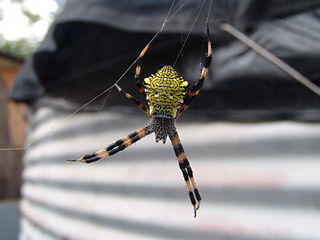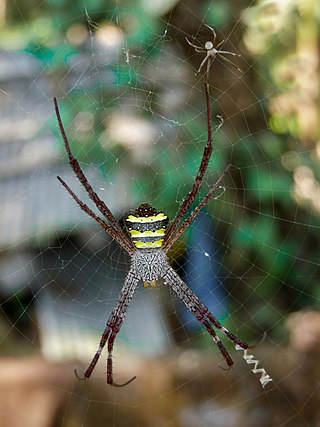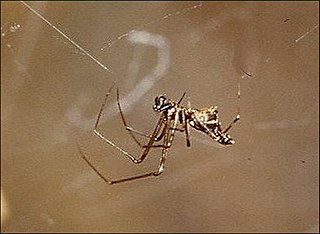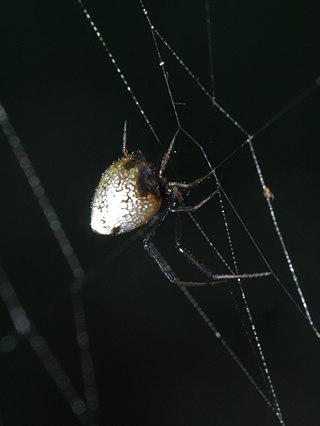
Theridiidae, also known as the tangle-web spiders, cobweb spiders and comb-footed spiders, is a large family of araneomorph spiders first described by Carl Jakob Sundevall in 1833. This diverse, globally distributed family includes over 3,000 species in 124 genera, and is the most common arthropod found in human dwellings throughout the world.

The genus name is a combination of the Ancient Greek "argyros" (άργυρος), meaning "silver", and the suffix "-odes", meaning "like".

Argiope appensa, also referred to as the Hawaiian garden spider or banana spider, is an orb-weaving spider belonging to the family Araneidae.

Argyrodes flavescens, commonly called the red and silver dewdrop spider is a species of spider belonging to the family Theridiidae. It is widely distributed in Southeast Asia and is also found in Sri Lanka. Like other members of this genus, this species is a kleptoparasite, living on the web of a larger spider and feeding off its prey. A. flavescens most commonly inhabits the webs of araneids.
Argyrodes lepidus is a species of tangle web spider in the genus Argyrodes found in New Zealand.

Argiope pulchella is a species of the orb-weaver spider family, Araneidae. Its range extends from India to China, Indochina, and Sumatra. It is a synanthropic species, often living in habitats associated with humans.
Argyrodes chionus is a species of tangle-web spider that is endemic to Aldabra in the Seychelles. It is found in dry shrubland at sea level. It is threatened by habitat deterioration due to sea level rise.

Argyrodes cognatus is a species of tangle-web spider that is endemic to the Seychelles, and can be found on Mahé, Conception, Silhouette and Marianne islands. It is found in woodland habitats where it spins orb webs in herbaceous vegetation. It is threatened by habitat deterioration due to invasive plants, especially Cinnamomum verum.
Argyrodes fissifrontellus is a species of tangle-web spider that is endemic to the Seychelles, and can be found on Mahé and Silhouette islands. It is found in woodland areas where it spins orb webs in vegetation, or is a keptoparasite in red-legged golden orb-web spider webs. It is threatened by habitat deterioration due to invasive plants, especially Cinnamomum verum.
Argyrodes rostratus is a species of tangle-web spider that is endemic to the Seychelles, and can be found on Mahé, Île Sèche, Cerf, Conception, Silhouette, Curieuse, Cousin, Aride, Praslin, La Digue, Grand Sœur, Felicite, Marianne, Denis islands and the Alphonse and St. François atolls. It is found in woodland, shrubby habitat and gardens, and is a kleptoparasite of red-legged golden orb-web spiders. It is threatened by habitat deterioration due to invasive plants, especially Cinnamomum verum.

Argyrodes fissifrons, the split-faced silver spider, is a species of spider of the genus Argyrodes. It is found from Sri Lanka to China and Australia.
Argyrodes nasutus, is a species of spider of the genus Argyrodes. It is endemic to Sri Lanka.
Argyrodes scintillulanus, is a species of spider of the genus Argyrodes. It is native to India and Sri Lanka.
Argyrodes insectus is a species of spiders of the family Theridiidae that is endemic in Cape Verde. The species was first described by Günter E. W. Schmidt in 2005.
Argyrodes scapulatus is a species of spiders of the family Theridiidae that is endemic in Cape Verde. The species was named and first described in 1994.
Argyrodes pluto is a species of cobweb spider in the family Theridiidae. It is found in the United States, Mexico, and Jamaica.

Argyrodes elevatus, commonly referred to as dew-drop spider, is part of the family Theridiidae that consists of more than 3,000 species. These spiders are most commonly found in subtropical and tropical regions in South and Central America, as well as southern regions of the United States. One of the key distinguishing characteristics of A. elevatus is its kleptoparasitic behavior through which it primarily procures food for survival. Typically 1 or 2 A. elevatus spiders preside in outer areas of webs built by other species of spiders, although it is possible for up to 45 spiders. There are two main mechanisms by which A. elevatus raid the hub of the host's web to steal insects preyed and wrapped by the host spider. A. elevatus follows an intricate course to the hub of the web to search for prey, using vibrational detection enhanced by laid out threads along the web to find and capture the insect. These spiders are highly efficient, with the theft lasting a maximum of 12 seconds and high success rates. This reliance on a host spider for food has led to adaptations in sleep schedules and alternate food sources to revolve around the host species activity. A. elevatus display a unique courtship routine in which male A. elevatus presents prey wrapped in silk as a nuptial gift to the female spider. The male spider approaches the female, carrying the nuptial gift on its chelicerae while communicating with a distinct courting vibration, followed by copulation. Approximately twenty-four hours after the A. elevatus courtship and copulation series of events, the female spider will lay one to two eggs on the outer regions of the host's web.
Philoponella oweni is a species of spider belonging to the family Uloboridae, the cribellate orb weavers. They are around 4.7–7.1 mm long in length and are primarily found in the arid southwestern parts of the United States. These spiders are most known for being semi-social, a rare trait within spiders. Semi-social, in the case of P. oweni, refers to the coexistence of facultatively communal and solitary females within the same habitat. These groups usually form in response to environmental factors, and often never involve true cooperation. This lack of true cooperation means these spiders do not share prey items, do not work together when spinning webs and do not care for one another's young. The coexistence of both solitary and communal species within the same habitat can be explained by both tactics have similar net reproductive success values. This was can be explained by comparing the number of eggs within egg cases to the number of surviving offspring for both tactics. The number of surviving offspring of communal and solitary beings does not vary significantly, which mostly due to the parasitism by pteromalid wasps. These wasp which prefer consume and parasitize communal P. oweni webs and eggs, counteracting the increase of eggs per egg case that communal spiders tend to produce over solitary.

Argyrodes antipodianus, also known as the dew drop spider, is a species of kleptoparasitic spider from the cobweb spider family found in Australia, New Zealand and New Caledonia.









